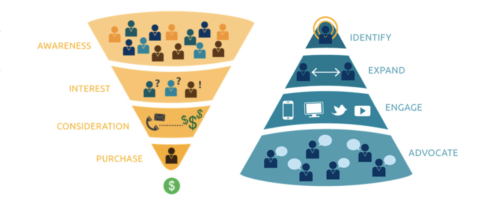Account-based marketing. It’s all the rage. Most B2B commercial teams are at least thinking of implementing account-based marketing (ABM) programs if they haven’t already. But why is it a must-have for life science sales and marketing teams?
What exactly is ABM?
Our favorite definition of ABM comes from Terminus, a leader in ABM tools and education: “A focused approach to B2B marketing in which marketing and sales teams work together to target best-fit accounts and turn them into customers.” We like this definition because it includes the two most important aspects of ABM—sales and marketing working together (yes, really!) and targeting accounts based on fit with your products and services. Instead of qualifying a lead after you have generated it, you seek leads specific to an organization you already know is a good match for your capabilities.
ABM “flips” the funnel—unlike traditional B2B marketing that seeks more leads through awareness-building across a broad audience—with the majority of marketing resources devoted to a prioritized set of high-value accounts. Then you engage accounts with content and messages that are highly targeted and personalized, making them both relevant and compelling.

Benefits of an ABM approach
A combination of authenticity and improved engagement has resulted in higher revenues and ROI for many companies, usually in less time than they experienced using conventional lead generation methods.
Some of the features of a functioning ABM program include:
- Fewer, but higher quality leads
- Increased revenue from fewer clients
- Healthier pipeline
- Up to 87% higher ROI on marketing activities (ITSMA, 2017)
There are numerous ways in which ABM can benefit your commercial teams, which we’ll cover in more detail, but generally, ABM might be a good fit if you:
- already know the attributes of specific, high-value accounts you want to sell to or collaborate with
- are keen to align your sales and marketing teams to improve ROI and increase funnel velocity
- aspire to create a superior experience for your prospects and customers and win their trust
Of the many reasons to adopt ABM, we’ll review a few and examine how ABM can help you overcome some of the challenges created by traditional life science marketing and sales strategies.
Reason 1: You Already Know Which Companies to Target
Well, maybe not the exact companies, but you certainly know the attributes and conditions for a high-value collaboration. In a noisy, complex, and crowded market, targeting and prioritizing the right accounts is critical to your success. This set of parameters is known in ABM as your ideal customer profile or ICP, which might include:
| ICP Attribute | Description |
| Technical Fit | Test or technology needs of your ideal customer that match the capabilities of your products, such as test methods or biomarkers |
| Research or Clinical Stage | The R&D stages that present the ideal time for you to establish a partnership |
| Therapeutic / Disease Area | The focus of an organization’s programs that aligns with yours |
| Organizational Health | Your financial health requirements for a partner (über-important when you’re selling into emerging Biopharma startups!) |
| Organizational Sales Model | The geographic focus of your efforts and the sales territory or accounts aligned to your team |
Even if you already know your ICP, you’ll still confront some obstacles:
- Figuring out exactly which accounts are a fit
- Identifying when program or org changes occur that make an account relevant to you
- Knowing when to reach out
- Identifying the right contact
Most teams take a manual, ad hoc approach to account research that undermines the gains the team has made in aligning to an ABM approach because it always leaves gaps and takes a crazy amount of time to get right. Also, figuring out who to reach out to at the right time is tricky.
Another quagmire teams face is getting sidetracked by jumping into tactics too quickly. Spending time up front to define and identify your target accounts is critical to the strategic foundation of your ABM program.
Reason 2: ABM Aligns Sales and Marketing Teams to Achieve Results
Sales has always used an account-based approach. Full stop. Sales leaders are concerned with uncovering specific challenges customers have and providing solutions to help overcome them. Marketing, on the other hand, is usually busy trying to define segments of customers who need our products and services, then crafting compelling campaigns to generate leads. B2B life science commercial teams have often struggled to bring sales, with its account-based approach, and marketing, with its focus on lead gen and “making stuff,” together to accelerate deal wins. Can ABM finally end the war between our sales and marketing teams and get everyone on the same “smarketing” page?
For ABM to function, your sales and marketing teams need to work together closely to define an ICP and identify target accounts. Once you’ve prioritized target accounts, it also calls for a combined effort to identify the right messages to the associated buyers and personalize your marketing programs to attract and engage them. This collaboration results in a more effective effort, where we’re all working in service to shared goals, instead of in the silos that often occur with traditional marketing approaches.
Reason 3: You Want to Build Trust and Engage Prospects and Customers in a Powerful Way
Highly personalized outreach creates excellent customer experiences. It positions your brand as informed, efficient, and authentic and can lead to increased sales, expansion, and loyalty. Personalization requires that you know who the stakeholders are at your target accounts and what their pain points are.
You also need to be aware of what is happening at those accounts—recent funding, mergers, new hires, publications, and R&D pipeline details that you can use in your approach. Developing a holistic understanding of your target accounts will help you define the right content—aligned with your capabilities— and help them through the buying process. But how can you gather all this data that is so vital to your ABM strategy?
You may already have data in your CRM or a marketing automation solution that can provide details on your target accounts, but it’s often out of date and limited in scope. Most teams rely on web searches, third-party data sets, and intelligence tools to mine for data. External data is incredibly important but equally as difficult to obtain for most industries.
However, in the life science industry, it’s a little easier to know what to evaluate, and a lot of information is publicly available, such as patents, publications, clinical trials, funding announcements, and R&D pipelines. The challenge with managing data sourcing is in the sheer amount of data available and obtaining it in both a timely and usable way so you can understand your customers’ stories and meet them where they are.
Why automated market intelligence is essential to your ABM program
Many life science commercial teams choose ABM as the cornerstone of their growth strategy because it helps them achieve the most important sales and marketing goals, such as increased sales funnel velocity and revenue. But most will be overwhelmed by the vast data and changes in this fast-paced industry. With over two million scientific articles published each year alone, it necessitates an intelligent, automated approach to:
- discover those organizations and drug programs that match your ICP, and
- monitor those organizations in real-time for relevant, compelling events that signal a sales opportunity
For example, the Amplion intelligence platform was built with ABM in mind. It helps commercial teams automatically identify target accounts using a custom ICP to incorporate all attributes and activities to develop a single, holistic understanding of each organization.
Here are just 6 of the ways Amplion helps you master your data to create a winning ABM program:
1. Discover your ideal accounts automatically
Qualified leads for research and drug programs that match your company’s capabilities and objectives are instantly generated based on your ICP.
2. Shrink the haystack to get to just specific and relevant accounts
Machine learning excludes everything that doesn’t match the parameters you’ve set, so you only see relevant accounts.
3. Team alignment
Sales and marketing can access the same account insights, so it’s easier to align around campaigns and content relevant to target accounts. It puts the whole commercial team “on the same page” in a tangible way.
4. Real-time buying signals
Alerts are automatically generated for relevant funding news, new hires, conference abstracts, new pubs, and more.
5. Sales enablement
Immediate access to all drugs, programs, firmographics, biomarkers, test methodologies, collaborations, and much more gives you insight into every aspect of an organization. You can personalize messaging for outreach and prepare for deal meetings.
6. Key stakeholders
We help you identify contacts specific to the programs you care about so you can reach out when the time is right.
Start ABM now, right where you are
Setting up your ABM program may seem overwhelming if you’re just getting started, but remember that taking time to get the strategy right is the most crucial step in developing a winning program. With sales and marketing working together as a team, you’ll be able to engage your entire commercial engine in attaining shared outcomes.
FEATURED RESOURCE: Territory Case Study
Amplion enables ABM success for life science teams by reducing account ID, prioritization, and research from months to days. Learn how our customers are amplifying their sales and marketing efforts using Amplion.
Want to upgrade your prospecting and lead gen processes for the better (and for good)?
Establishing best practices for your sales and marketing team’s day-to-day prospecting and lead gen workflows can
help everyone on your team achieve rockstar results.
SOURCES:
Terminus: https://terminus.com/blog/what-is-account-based-marketing/.
ITSMA: ABM Beyond Revenue: The Other Two R’s https://www.itsma.com/abm-beyond-revenue-two-rs/
Funnel image courtesy of flipmyfunnel.com


